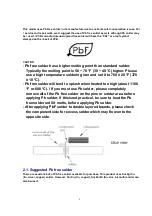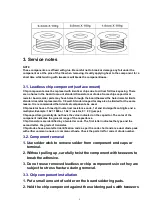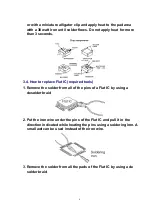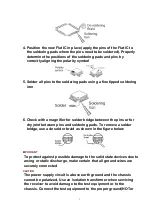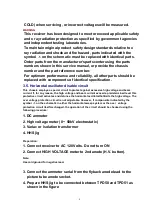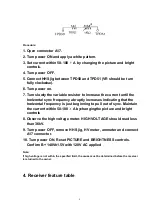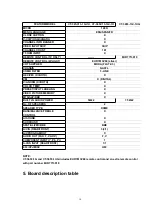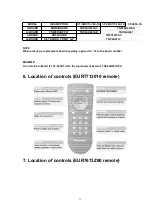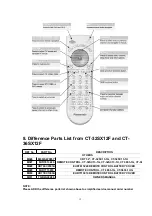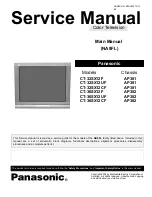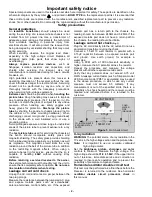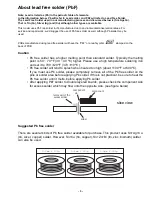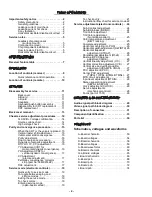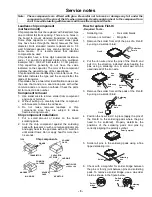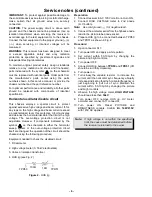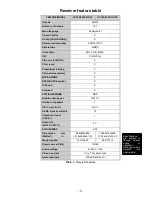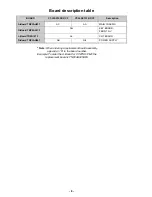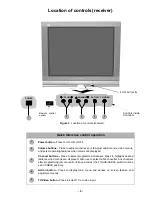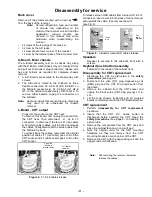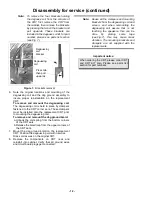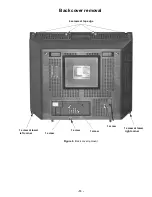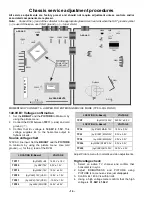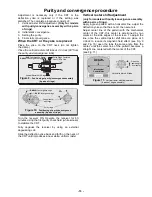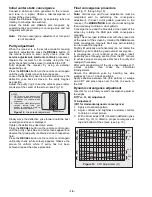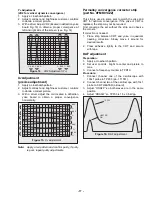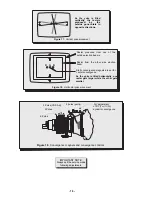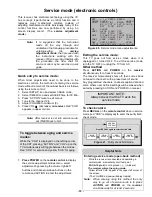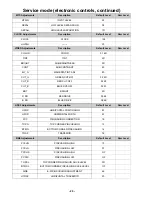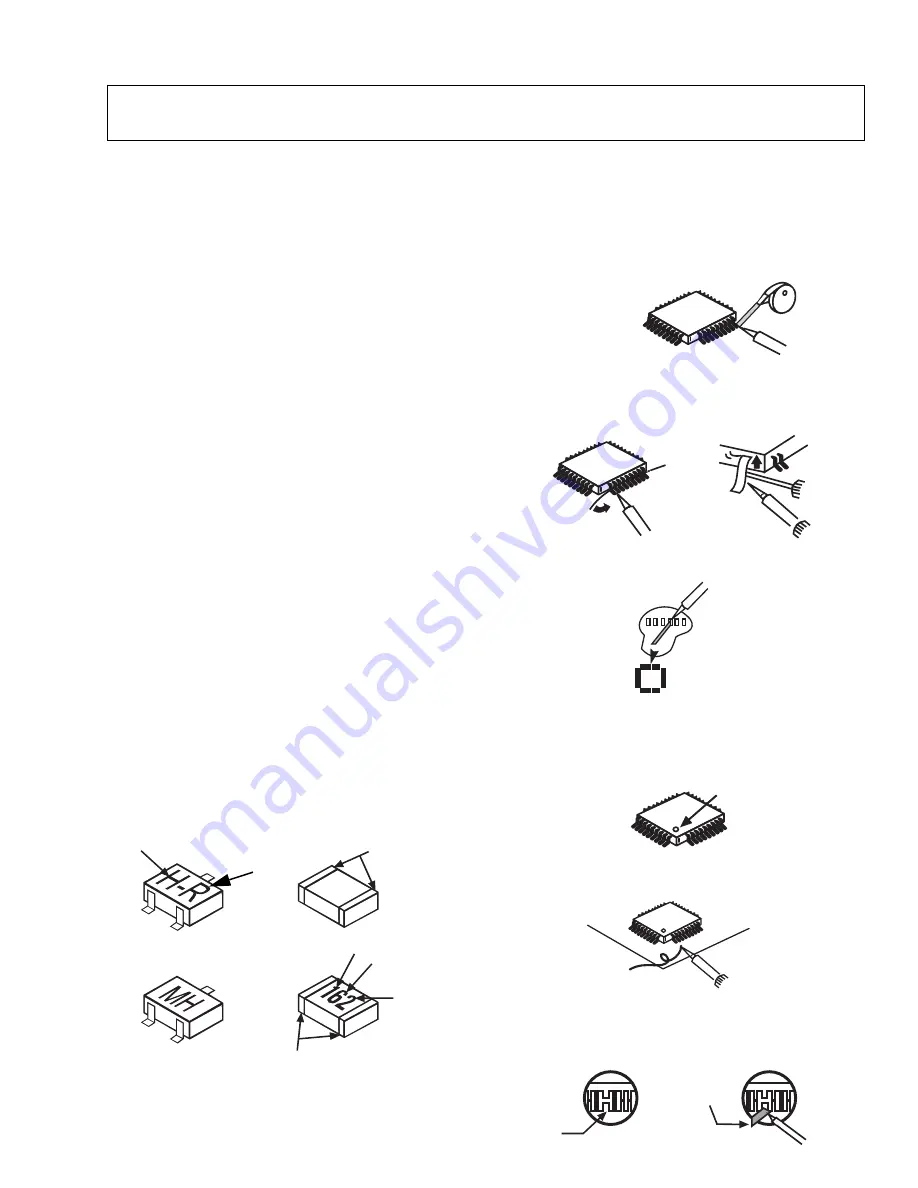
- 5 -
Service notes
Leadless chip component
(surface mount)
Chip components must be replaced with identical chips
due to critical foil track spacing. There are no holes in
the board to mount standard transistors or diodes.
Some chips capacitor or resistor board solder pads
may have holes through the board, however the hole
diameter limits standard resistor replacement to 1/8
watt. Standard capacitor may also be limited for the
same
reason.
It
is
recommended
that
identical
components be used.
Chip resistor have a three digit numerical resistance
code - 1st and 2nd significant digits and a multiplier.
Example: 162 = 1600 or 1.6k
Ω
resistor, 0 = 0
Ω
(jumper).
Chip capacitors generally do not have the value
indicated on the capacitor. The color of the component
indicates the general range of the capacitance.
Chip transistors are identified by a two letter code. The
first letter indicates the type and the second letter, the
grade of transistor.
Chip diodes have a two letter identification code as per
the code chart and are a dual diode pack with either
common anode or common cathode. Check the parts
list for correct diode number.
Component removal
1.
Use solder wick to remove solder from component
end caps or terminal.
2.
Without pulling up, carefully twist the component
with tweezers to break the adhesive.
3.
Do
not
reuse
removed
leadless
or
chip
components since they are subject to stress
fracture during removal.
Chip component installation
1.
Put a small amount of solder on the board
soldering pads.
2.
Hold the chip component against the soldering
pads with tweezers or with a miniature alligator clip
and apply heat to the pad area with a 30 watt iron
until solder flows. Do not apply heat for more than
3 seconds.
How to replace Flat-IC
- Required Tools -
1.
Remove the solder from all of the pins of a Flat-IC
by using a de-solder braid.
2.
Put the iron wire under the pins of the Flat-IC and
pull it in the direction indicated while heating the
pins using a soldering iron. A small awl can be
used instead of the iron wire.
3.
Remove the solder from all the pads of the Flat-IC
by using a de-solder braid.
4.
Position the new Flat-IC in place (apply the pins of
the Flat-IC to the soldering pads where the pins
need to be soldered). Properly determine the
positions of the soldering pads and pins by
correctly aligning the polarity symbol.
5.
Solder all pins to the soldering pads using a fine
tipped soldering iron.
6.
Check with a magnifier for solder bridge between
the pins or for dry joint between pins and soldering
pads. To remove a solder bridge, use a de-solder
braid as shown in the figure below.
Note:
These components are affixed with glue. Be careful not to break or damage any foil under the
component or at the pins of the ICs when removing. Usually applying heat to the component for a
short time while twisting with tweezers will break the component loose.
c
b
e
Chip components
TRANSISTOR
CAPACITOR
RESISTOR
MH DIODE
SOLDER
CAPS
SOLDER
CAPS
1ST DIGIT
2ND DIGIT
MULTIPLIER
=1600 = 1.6k
GRADE
TYPE
COMMON
ANODES
CATHODE
•
Soldering iron
•
De-solder braids
•
Iron wire or small awl
•
Magnifier
Flat-IC
De-Solder
braid
Pull
Iron
wire
Awl
Soldering
iron
Soldering
iron
Soldering
iron
De-Solder
braid
Flat IC
123.....
Polarity symbol
Soldering
iron
Solder
De-Solder
braid
Solder
bridge
Soldering
iron
Содержание CT-32SC13-1G
Страница 63: ... 50 A Board ...
Страница 65: ... 52 ERJ6GEYJ183V NP2AH037AC ERENCES A Board ...
Страница 66: ... 53 A Board ...
Страница 69: ... 56 D Board ...
Страница 70: ... 57 D Board ...
Страница 71: ... 58 D Board ...
Страница 74: ... 61 notes NOTES ...
Страница 75: ... 62 G Board ...
Страница 76: ... 63 G Board ...
Страница 77: ... 64 G Board ...
Страница 79: ... 66 L Board ...
Страница 80: ... 67 L Board ...
Страница 81: ... 68 A PCB ...
Страница 82: ... 69 A PCB ...
Страница 83: ... 70 D PCB ...
Страница 84: ... 71 D PCB ...
Страница 85: ... 72 G PCB ...
Страница 86: ... 73 G PCB ...
Страница 87: ... 74 L PCB ...
Страница 88: ... 75 notes NOTES ...

